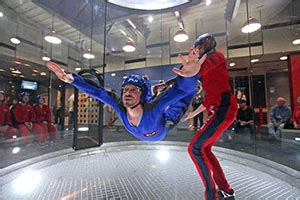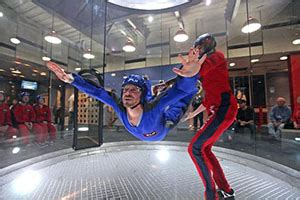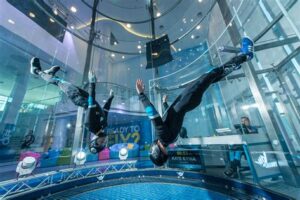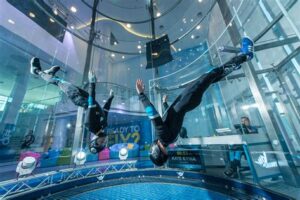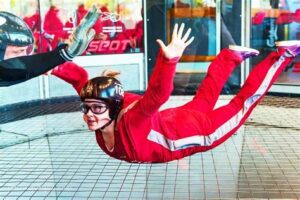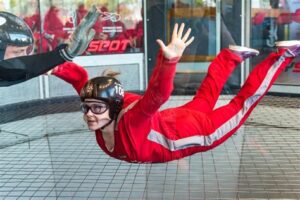Table of Contents
Is indoor skydiving dangerous? Find out the risks and safety measures associated with this thrilling activity. Discover how indoor skydiving simulates the experience of freefalling in a controlled environment, making it a safer alternative to traditional outdoor skydiving. Explore the precautions taken by trained instructors to ensure your safety during an indoor skydiving session. Unleash your adventurous spirit and experience the thrill without the potential dangers of jumping from a plane!
Indoor skydiving, also known as vertical wind tunnel flying, is a thrilling and adrenaline-pumping activity that has gained immense popularity in recent years. But what lurks beneath the seemingly exhilarating experience? Is indoor skydiving truly as safe as it appears? In this article, we will delve into the potential dangers associated with this gravity-defying sport, shedding light on the risks involved and providing valuable insights for those who seek to explore the world of indoor skydiving.
Introduction
Indoor skydiving is an exhilarating experience that allows individuals to experience the sensation of freefalling without jumping out of an airplane. This adrenaline-pumping activity has gained popularity in recent years, attracting thrill-seekers and adventure enthusiasts from all walks of life. However, many people wonder whether indoor skydiving is dangerous. In this article, we will explore the potential risks associated with indoor skydiving and provide instructions on how to ensure a safe and enjoyable experience.
The Controlled Environment
One of the key factors that make indoor skydiving relatively safe is the controlled environment in which it takes place. Unlike outdoor skydiving, where weather conditions and other external factors can pose risks, indoor skydiving facilities maintain a controlled atmosphere. The wind speeds and temperature within the vertical wind tunnel are carefully regulated to ensure the safety of participants.
Qualified Instructors
Indoor skydiving centers employ qualified instructors who are trained to guide participants throughout the experience. These instructors have undergone extensive training in skydiving techniques and safety protocols. They will provide necessary instructions, demonstrate proper body positioning, and supervise each session to prevent accidents or injuries.
Physical Fitness Requirements
While indoor skydiving is generally safe, it does require a certain level of physical fitness. Participants must be in good health, free from any medical conditions that could be aggravated by the forces of wind or sudden movements. It is important to disclose any relevant health information to the instructors before participating in the activity.
Proper Safety Gear
Indoor skydiving centers provide participants with proper safety gear, including jumpsuits, goggles, helmets, and earplugs. These items are designed to protect individuals from potential hazards during the flight. It is crucial to wear and use the provided safety equipment correctly to minimize the risk of injuries.
The Importance of Listening to Instructions
Listening carefully to the instructions provided by the instructors is essential for a safe indoor skydiving experience. They will explain the correct body positions, hand signals, and techniques to follow during the flight. Following their guidance helps maintain control and stability while enjoying the sensation of freefall.
Understanding the Risks
Although indoor skydiving is considered a safe activity, it is not entirely risk-free. Participants should be aware of the potential risks involved, such as collisions with other flyers or the walls of the wind tunnel, as well as the possibility of minor injuries like bruises or muscle strains. Understanding these risks will help individuals approach the activity with caution and take necessary precautions.
Limitations for Certain Individuals
While indoor skydiving is generally accessible to people of various abilities, there are certain limitations for individuals with specific health conditions. Pregnant women, people with back or neck injuries, and those with heart conditions are often advised against participating in indoor skydiving due to the potential risks it may pose to their health. It is essential to consult a healthcare professional if you have any concerns.
Age Restrictions
Most indoor skydiving facilities have age restrictions in place to ensure the safety of participants. While the minimum age requirement may vary, it is typically around 3-4 years old. Children under a certain age may not have the physical capability to maintain the correct body position or understand the instructions given by instructors. Always check with the facility regarding their age restrictions before planning a visit.
Conclusion
In summary, indoor skydiving can be a thrilling and relatively safe activity when proper precautions are taken. By choosing a reputable facility, listening to instructions, and using the provided safety gear correctly, participants can enjoy the exhilaration of freefalling in a controlled environment. It is important to recognize the potential risks involved and adhere to any restrictions or limitations set by the facility to ensure a safe and enjoyable experience for all.
Is Indoor Skydiving Dangerous?
Indoor skydiving is a thrilling sport that simulates the sensation of freefalling in a controlled environment. However, safety is a primary concern in any physical activity, including indoor skydiving. This guide aims to provide an objective analysis of the potential risks associated with indoor skydiving.
Safety Measures
Indoor skydiving facilities have implemented strict safety protocols to minimize risks. Before participating, individuals are required to attend a safety briefing where instructors explain body positioning and emergency procedures. The presence of trained professionals guarantees that participants are well-guided throughout the entire experience. These safety measures ensure that the risk of accidents is minimized.
Physical Injuries
Although indoor skydiving is generally safe, there is a slight risk of physical injuries such as minor bruises or muscle strains. To minimize the chances of injury, participants are advised to wear appropriate gear, including helmets and protective clothing. Following the instructor’s guidelines and maintaining proper body control greatly reduces the risk of physical harm. It is important to prioritize safety and take necessary precautions to prevent any potential injuries.
Emotional Well-being
Some individuals may experience heightened anxiety or fear during their first indoor skydiving session, but these emotions are often temporary. Participating in a group setting often alleviates anxiety by fostering a supportive and encouraging environment. The feeling of accomplishment after completing a successful indoor skydiving session can boost confidence and provide a sense of empowerment. It is important to recognize and address any emotional concerns, ensuring a positive experience for all participants.
Equipment Malfunctions
Indoor skydiving facilities regularly inspect and maintain their equipment to ensure it functions properly. Instructors are trained to identify any potential equipment malfunctions and address them prior to allowing participants to fly. The likelihood of encountering equipment malfunctions is extremely low due to rigorous safety checks performed by professionals. Trusting the expertise of trained instructors and the maintenance practices of the facility can help alleviate concerns about equipment failures.
Pre-existing Medical Conditions
Individuals with pre-existing medical conditions, such as heart or lung problems, should consult their healthcare provider before engaging in indoor skydiving. Informing the instructors about any medical conditions or concerns beforehand allows them to offer appropriate guidance and support. Most facilities have guidelines regarding medical restrictions, ensuring the safety and well-being of all participants. It is crucial to prioritize personal health and follow professional advice when engaging in any physical activity.
Impact of Weather Conditions
Unlike outdoor skydiving, indoor skydiving is not significantly affected by external weather conditions. Indoor facilities maintain a controlled environment, allowing operations to continue regardless of rain, wind, or temperature variations. The consistent and stable conditions in indoor skydiving eliminate potential weather-related risks or disruptions. Participants can enjoy the sport without worrying about the unpredictability of weather conditions.
Overall Risk Assessment
When comparing indoor skydiving to other adventure sports, the risk level is relatively low. Proper training, qualified instructors, and adherence to safety protocols greatly minimize the potential dangers associated with indoor skydiving. It is important for participants to listen to their instructors, follow safety guidelines, and assess their personal physical condition before engaging in any activity. By taking these precautions, individuals can enjoy the thrill of indoor skydiving while ensuring their safety.
In conclusion, indoor skydiving can be an exhilarating experience with minimal risks when proper safety measures are followed. By prioritizing safety, participants can enjoy the sport and reap the benefits of this thrilling activity.
In my point of view, indoor skydiving can be considered as a relatively safe activity when proper instructions and safety measures are followed. However, it is important to acknowledge that there are inherent risks associated with any extreme sport or recreational activity.
When participating in indoor skydiving, it is crucial to carefully follow the provided instructions to ensure personal safety:
-
Wear appropriate attire: Dress in comfortable clothing that allows for ease of movement. Avoid wearing loose items such as jewelry or accessories that could potentially get caught in the wind tunnel.
-
Listen attentively to the instructor: Pay close attention to the instructor’s guidance and follow their directions precisely. They will provide important information on body positioning, hand signals, and safety precautions.
-
Maintain proper body position: Maintain a stable and balanced body position while inside the wind tunnel. This includes keeping your chin up, arching your back slightly, and extending your legs and arms.
-
Be aware of surroundings: Stay vigilant and mindful of other participants in the wind tunnel. Avoid collisions by maintaining a safe distance from others and following designated flight paths.
-
Trust the equipment: Have faith in the safety measures implemented by the facility. Indoor skydiving venues typically utilize state-of-the-art wind tunnels and provide participants with appropriate safety gear such as helmets and goggles.
-
Follow age and health restrictions: Ensure that you meet the minimum age and health requirements set by the facility. Certain medical conditions or physical limitations may make indoor skydiving unsuitable for some individuals.
-
Ask questions if unsure: If you have any doubts or concerns, don’t hesitate to ask the instructor for clarification. It is better to seek guidance and fully understand the instructions before engaging in the activity.
While indoor skydiving may have its risks, following these instructions and safety guidelines can significantly minimize the chances of accidents or injuries. Ultimately, it is important to prioritize personal safety and enjoy the exhilarating experience of indoor skydiving within a controlled and supervised environment.
Thank you for taking the time to visit our blog and read about the thrilling world of indoor skydiving. We hope that this article has provided you with valuable insights and information regarding the safety aspects of this exhilarating activity. As we conclude, it is important to understand that while indoor skydiving may have its risks, when performed following proper instructions and guidelines, it can be a safe and enjoyable experience for everyone involved.
Firstly, it is crucial to emphasize that indoor skydiving is a highly controlled and regulated sport. The facilities are equipped with state-of-the-art technology and safety measures to ensure the well-being of participants. Before engaging in any indoor skydiving session, individuals are required to undergo thorough training sessions conducted by certified instructors. These experts provide detailed instructions on body positions, hand signals, and safety protocols. By following these instructions, participants can minimize the risks associated with indoor skydiving and focus on enjoying the unique sensation of freefall.
Additionally, it is worth noting that indoor skydiving eliminates certain dangers that are inherent in traditional outdoor skydiving. With indoor skydiving, there is no need to worry about adverse weather conditions or unpredictable winds that could affect the jump. Furthermore, the controlled environment of an indoor facility eliminates the risk of landing off target or colliding with obstacles. This controlled setting ensures that even beginners can safely experience the exhilaration of skydiving without the added concerns typically associated with outdoor jumps.
In conclusion, while there are inherent risks associated with any adventurous activity, indoor skydiving can be a safe and thrilling experience when proper instructions and guidelines are followed. The regulated environment and certified instructors ensure that participants are equipped with the necessary knowledge and skills to enjoy this sport in a secure manner. So, if you have always dreamed of the feeling of freefall and the rush of adrenaline, indoor skydiving might just be the perfect activity for you. Remember, safety should always be a priority, so listen carefully to your instructors and enjoy the incredible sensation of soaring through the air in a controlled and safe environment.
We hope you found this article informative and inspiring. If you have any further questions or would like to share your own experience with indoor skydiving, please feel free to leave a comment below. Safe travels and happy skydiving!
.
Is Indoor Skydiving Dangerous? People Also Ask
-
What are the risks associated with indoor skydiving?
Indoor skydiving is generally considered a safe activity with minimal risks. However, as with any physical activity, there are potential risks involved. These may include minor injuries such as bumps, bruises, or muscle strains if proper safety precautions are not followed. It is important to listen attentively to the instructors and follow their instructions to minimize any risks.
-
Can you get injured while indoor skydiving?
While the chances of getting injured during indoor skydiving are relatively low, accidents can still occur if safety guidelines are not followed. Potential injuries could include sprains, strains, or minor cuts if participants fail to maintain proper body positions or collide with walls. However, with proper training, supervision, and adherence to safety protocols, the risk of injury is greatly reduced.
-
Are there age restrictions for indoor skydiving?
Age restrictions for indoor skydiving may vary depending on the facility and country. Most indoor skydiving centers have a minimum age requirement of around four years old. However, certain facilities may have additional height, weight, or health restrictions in place. It is advisable to check with the specific facility beforehand to ensure compliance with their age and other requirements.
-
What happens if the wind tunnel malfunctions during indoor skydiving?
Indoor skydiving facilities have strict safety measures in place to prevent malfunctions. In the rare event of a malfunction, trained instructors and staff are trained to handle such situations and ensure the safety of participants. Emergency protocols and backup systems are typically in place to quickly address any technical issues, minimizing the risk to individuals inside the wind tunnel.
-
Is it possible to get motion sickness while indoor skydiving?
Some individuals may experience motion sickness or dizziness during indoor skydiving due to the sensation of air currents. However, this is relatively uncommon, and most people adapt to the sensation fairly quickly. If you have a history of motion sickness, it may be helpful to inform the instructors beforehand, as they can provide guidance on managing any discomfort.
Overall, indoor skydiving is considered a safe activity when proper safety guidelines and instructions are followed. By listening attentively to the instructors, maintaining correct body positions, and adhering to safety protocols, the risks associated with indoor skydiving can be significantly minimized.

